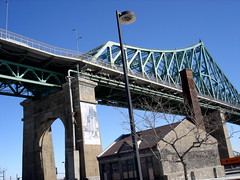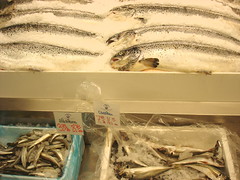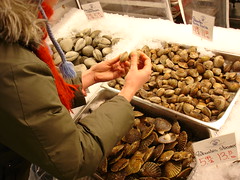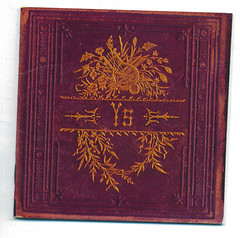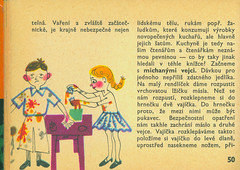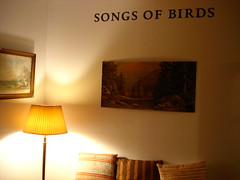E & D Special, rev. ed.
I once had a radio show in Vancouver that was purportedly simulcast from a rough-and-tumble bar "at the corner of Main & Main" called The Hi-Hat. The idea was that every other Saturday night the radio station sent its mobile unit to the Hi-Hat in order to capture the DJ set and the atmosphere live and then spread the joy via the miracle of radio communications. The, uh, illusion was maintained through the use of ambient sound effects (crowd chatter, glasses clinking, a band tuning up, etc.) and my running banter with the bartender, Nick, and some of the other imaginary regulars. But, hey, enough about me, 'cause we've got big news to report.
What follows is the latest breakthrough from our AEB-affiliate test kitchen in Brooklyn, down at the intersection of Ellwood & Dumont. Our mac lab there has been working furiously for some time to develop a master version of that American classic, macaroni & cheese. In order to do so, they had to face up to the fact that like virtually every other aspect of American cuisine and American culture more generally, good old-fashioned mac & cheese, that staple of home kitchens and diners from sea to shining sea, really isn't all that American. It's become so, yes, but its history dates back hundreds of years before Jamestown, Plymouth Rock, Schoolhouse Rock, or any of the rest of that jazz.
First off, as many have pointed out before and many of you out there already know, that myth about Marco Polo discovering pasta in China then bringing it back to Venice and introducing it to the Italian palate is just that: a myth. He might very well have brought some noodles back from Cathay with him (who could blame him?), but pasta had been known on the Italian peninsula in a variety of forms for quite a while (some say well over 1,000 years) by the time the Polos returned and published their famous account of their travels, and macaroni was one of the most basic types. So basic that it became known as a generic term in Italian (and later in English) for virtually all pasta that was not flat, like lasagne, or stuffed, like ravioli. So basic that its name doesn't appear to have been derived from a word having to do with its now characteristic shape, as one might have expected, but instead seems to have come from the old Italian word maccare, "to pound" (durum wheat, presumably), the same word that forms the root of macaroon and macaron (a dessert made of pounded almonds) and the modern Italian word macarie, or "rubble."
In any case, by the 14th and 15th centuries, not only was macaroni well known throughout Italy, it had already made its way to England, and recipes for macaroni and cheese were already in circulation in both places. Thus, The Forme of Cury, ca. 1390, a collection of recipes compiled by the "Master-Cooks of King Richard II." despite its evident difficulties with Italian names, contains the following Ur-mac & cheese:
Macrows: take and make a thynne foyle of dowh, and kerve it on peces, and cast hem on boillyng water & seeth it well. Take chese and grate it and butter cast bynethen and above as losyns and serue forth.
or
Macrows: take and make a thin foil of dough, and carve it into pieces, and cast them into boiling water, and seeth it well. Take cheese and grate it and butter cast beneath and above... and serve forth.
While 30 years later, the man credited with having compiled early Modern Italy's culinary repertoire, "the first modern cookery book," Maestro Martino da Como, included this somewhat more detailed recipe for Maccaroni siciliani in his Libro de arte coquinaria, or The Book of Culinary Art:
Make a dough of the best flour, mixed with the white of one egg and rosewater, blended with water. If you want to make only two plates of it add only one or two yolks, making this a very tough dough, and roll small round sticks a handswidth in length and the thickness of straw. Take an iron rod a handswidth long and a cord thick and use to roll the sticks of dough on the table with both hands. Then pull the metal rod out and a macaroni with a hollowed center remains. Dry these macaronis in the sun. Once dry, they can be kept for two to three years. Cook in water or a good meat stock and sprinkle with grated cheese when you serve them with melted butter and mild spices.
By the late-19th century, not only was macaroni and cheese very well known in England--due in no small part to the craze for all things Italian, including pasta, that swept through the English aristocracy the century before--it had actually been so firmly established as part of the English culinary repertoire that it was actually beginning to lose its sense of Italianess. Key to this shift was the work of Eliza Acton, whose 1845 cookbook promoted the use of English cheese in the making of macaroni and cheese, not out of jingoism necessarily, but because she claimed to prefer the results over more traditional Continental methods. Mrs. Beeton's version, on the other hand, listed under the subject heading "Farinaceous preparations," was more clearly derivative of French variations, where the end result is more of a "macaroni and cheese sauce" than a "macaroni and cheese."
American macaroni and cheese appears to be largely derivative of the English tradition. There were certainly other influences, and Thomas Jefferson himself is credited with having spread the craze on American soil, having returned from his ambassadorship to France a convert, but American versions of macaroni and cheese appear to have followed the English lead, probably because the early American cheesemaking tradition was so English in its orientation. That said, I also wouldn't want to underestimate the influence of the song "Yankee Doodle" in popularizing the dish, even if the most common version of the song is derisively anti-American and the "macaroni" in question is a reference to Americans as fashion victims that has virtually nothing to do with cuisine*. At the very least, the song made the term widely known in America, across classes. Surely, that couldn't have hurt the dish's popularization. I haven't checked to see if De Tocqueville has anything to say on the subject, but I wouldn't be surprised if he's got some pithy remark somewhere in Democracy in America that touches on this phenomenon. [Actually, given the timelines and America's reputation for ingenuity, who knows, maybe it was America's use of English-style cheddars and its democratization of the dish that convinced Acton et al. to transform macaroni and cheese into something more popularly English. Maybe the standard English macaroni and cheese is in some ways derivative of the American tradition! Better yet, maybe there's some Canadian angle that trumps them both!]
Anyway, all of this is to say that what our team at the mac lab settled on was a recipe with big-city sophistication and back-country charm, one that was decidedly Anglo-American, but nonetheless managed to include French and Italian touches dating all the way back to Maestro Martino (no rosewater, but lots of spice). As is befitting a true macaroni and cheese, you'll find no tricks, no gimmicks of any kind in this recipe, just quality ingredients like artisanal cheddar,
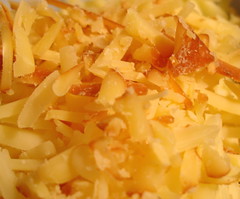
smoked bacon,
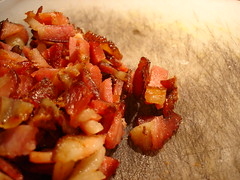
and nutmeg,
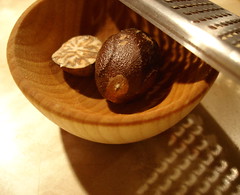
lots of nutmeg, all prepared with care.
In the "Personal Passions" section of his Simple Cooking, John Thorne describes the making of macaroni and cheese as a signal example of something he calls "resonance." As he puts it,
One important dimension of kitchen experience is what I have previously called--for lack of a better term--resonance, a palpable depth to the things out of which we make our meals. In their way, these things speak, and it is our ability to hear, to enter into a kind of conversation with them that marks our crossing over from kitchen worker, however skilled, to true cook.
In the modern kitchen, this resonance is often only barely perceptible; someone else in the kitchen might not be aware of it at all. But the cook, even if not consciously attentive to it, is aware, because to the extent we coax it into being, we increase the reality, the meaningfulness of the cooking experience. And this resonance is strongest in those ordinary, familiar dishes with no aura of specialness to distract us from the actual experience of making.
As Thorne emphasizes--and this is true of so many of the dishes we champion here in the pages of "...an endless banquet"--
there is... nothing in the making of macaroni and cheese... to offer true challenge to the good cook. If kudos are wanted, they must be earned making something else. But mastery of the difficult is only one of the rewards of cooking, and it is worth remembering now and again that there is a humbler gift a dish can give the cook: the pleasure of its company.
Here's to good company!
E & D Special Mac and Cheese
7 tbsp butter
1 onion, finely chopped
3 cloves of garlic, minced
3 tbsp all-purpose flour
1/2 cup breadcrumbs
1/2 lb thick-cut smoked bacon (we used Dakin Farm, but our mac lab recommends good-quality Polish bacon)
4 cups milk
1 cup sharp white cheddar, grated (we used a combination of Isle aux Grues 2-year and Shelburne Farm smoked)
1 cup Gruyère, grated
1/4 cup Parmesan, grated
1 lb macaroni, cooked to the point just prior to al dente
freshly ground nutmeg to taste
1/4 – 1/2 tsp mixed smoked and sweet paprika
freshly ground pepper to taste
salt to taste
Cook your pasta until just before it becomes al dente. As Thorne puts it, you want your pasta to still have, "a tiny bit of 'spine' or crunch, so it can finish its cooking absorbing the taste and savor of the sauce."
Preheat your oven to 400º F. Fry the bacon. Set it aside to cool, saving the bacon drippings, and when it has cooled, chop it into small pieces.
Melt 4 tbsp of the butter in the bacon drippings. Add the onion and sauté over medium heat for 3-4 minutes. Add the garlic and sauté until the onion is golden. Add the flour and sauté for 2-3 minutes. Whisk the milk in, a few tablespoons at a time, and continue cooking over medium heat until you’ve poured in all the milk and the mixture is beginning to take on the characteristics of a thick shake. Add the spices and adjust the seasonings. Use enough nutmeg to give the béchamel-like sauce a nice nutmeggy flavor, but not enough to make you hallucinate wildly (the mac and cheese will accomplish this on its own).
Add the cheese in portions and stir until the cheese has melted and the sauce is smooth again. Stir in the cooked pasta, then the bacon.
Butter the inside of a large lidded casserole with another tbsp of the butter. Pour the mac and cheese mixture in the buttered casserole, top with the breadcrumbs, then the Parmesan. Take the final 2 tbsp of butter, cut into several nubbins, and add these to the top of the gratin.
Bake in the oven for 20 minutes with the lid on. Remove the lid and bake for another 10 minutes. Serve hot with a nice salad. We recommend a salad with apple or pear in it.
Have your own mac & cheese master recipe that you'd like to share with the AEB mac lab? Do tell. Send us an email or post a comment.
aj
sources:
The Forme of Cury
John Thorne, "Macaroni and Cheese," Simple Cooking
Alan Davidson, The Penguin Companion to Food
Mark Kurlansky, "Martino's Sicilian Macaroni," Choice Cuts: A Miscellany of Food Writing
Mrs. Beeton's Every-day Cookery
Bill Buford, Heat
*The term "macaroni" was used to describe a type of 18th English fop with a propensity for garish wigs (whose curls were said to resemble tubular pasta on a grand scale) and affected speech.
p.s. very special thanks to S.C.E.
Erratum: Apparently the AEB mac lab moved recently unbeknownst even to us. It's no longer at the intersection of Ellwood & Dumont as reported; it's on Ellwood a few blocks away from Dumont. We'll leave the names of the post and the recipe as is, though, for posterity's sake.
